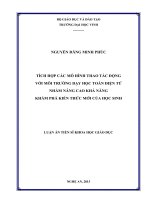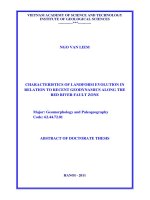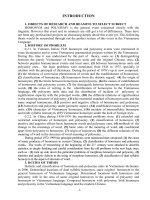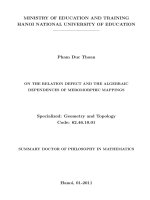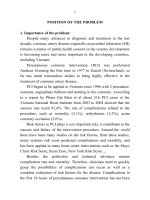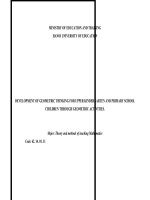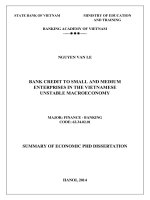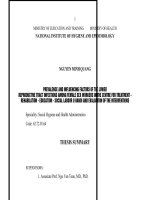tích hợp các mô hình thao tác động với môi trường dạy học toán điện tử nhằm nâng cao khả năng khám phá kiến thức mới của học sinh bản tóm tắt tiếng anh
Bạn đang xem bản rút gọn của tài liệu. Xem và tải ngay bản đầy đủ của tài liệu tại đây (418.85 KB, 27 trang )
MINISTRY OF EDUCATION AND TRAINING
VINH UNIVERSITY
NGUYEN DANG MINH PHUC
INTEGRATING DYNAMIC MANIPULATIVE MODELS
WITH ELECTRONIC MATHEMATICS TEACHING
AND LEARNING ENVIRONMENT FOR ENHANCING
THE STUDENTS’ ABILITY OF EXPLORING NEW
KNOWLEDGE
Major: Theory and Methods of Teaching Mathematics
Code number: 62.14.01.11
SUMMARY OF THE DOCTORAL THESIS OF
EDUCATION SCIENCE
NGHE AN, 2013
ii
The work was done at Vinh University
The supervisor: Assoc. Prof. Dr. Tran Vui
Reviewer 1: Assoc. Prof. Dr. Tran Kieu
Reviewer 2: Assoc. Prof. Dr. Trinh Thanh Hai
Reviewer 3: Dr. Tran Trung
The thesis will be defensed in front of the Board of University level in Vin
University,
On hours date month year………
This thesis can be found at:
- National Library of Vietnam, 31 Trang Thi street, Hanoi
- Information Center – Library Nguyen Thuc Hao, Vinh University
1
INTRODUCTION
The mathematical objects shown on the blackboard or on paper are static, the
characteristics and their relationship often described by the language or symbolic
representations.
However, in a dynamic geometry environment, the object will show the
characteristic behavior and can become the raw material used to "experiment". The
idea for students to perform experiments as an empirically they often do in the other
sciences subjects of mathematics educators have become ever more viable in the
dynamic geometry environments. They can conduct the experiment for suggesting
hypotheses, verifying results, detecting invariants, finding relationships to
constructing new knowledge.
With this study, we hope to survey the status of students learning mathematics that
forms the foundation for using software in teaching, research the constructing of
electronics teaching and learning environments, integrating the dynamic mathematics
models to the environment to help improve students' ability to discover new
knowledge.
CHAPTER 1: INTRODUCTION STUDY BACKGROUND
1.1. Introduction
With the student center of the teaching process, the autonomy of students in
discovering knowledge was impressed. In a positive learning environment, they have
many more conditions in the exchanges, study with classmates through learning
group or through interaction. The dynamic manipulative models designed on the
software can help students to discover knowledge through operations on that model
with initial guidance. Students will reduce the dependency on teachers in the
reception of new knowledge. Instead, base on to the active and their initiative actions,
students will discover new knowledge with teachers as mentors.
The development of a positive learning environment depends on many factors such
as the lesson contents, the existing infrastructures, teachers’ capacity, the ability to
adapt to the environment of the students. Teachers actually are researchers based on
reality to build a suitable environment, using appropriate teaching equipment and
integrating process of equipment into that environment for meeting effective teaching
and learning.
1.2. Research needs
Dynamic geometry software, with its original strength, which can preserve the
invariance of the geometrics images or keep the rational role relationships of objects.
2
With the interaction between students and computer models, students can discover,
explore new knowledge for themselves. With learning environments that use teaching
facilities in the application of information technology, students have more
opportunities to explore mathematical knowledge. The problem is the need of how to
create learning environments, design and build dynamic mathematics models as well
as the integrating models into electronic learning environment to be effective in
teaching and learning.
1.3. The study
The study needs to find a way to integrate the dynamic mathematics models to this
learning environment to build e-learning environments to enhance mathematical
thinking and experimentation. We chose the research topic: "Integrating dynamic
manipulative models with electronic mathematics teaching and learning for
enhancing the students’ ability to explore new knowledge"
1.4. Research purposes
The purpose of the thesis is to:
Study the effectiveness of dynamic manipulative models in supporting to
enhance the students’ ability to explore new knowledge.
Research and develop electronic teaching and learning in supporting to enhance
the students’ ability to explore new knowledge.
Develope the students’ ability to explore new knowledge through abduction and
induction when conducting the investigation on electronic dynamic manipulative
models.
Research on the experiment mathematics on dynamic manipulative models in
supporting students enhancing their ability of exploring new knowledge.
1.5. Research question
With the goal of integrating the model with environmental manipulation in
electronic teaching to enhance the ability to discover new knowledge of students, this
study proposed scientific hypothesis as follows:
If the model integrated with environmental manipulation in electronic teaching a
scientific basis will enhance the ability to discover new knowledge through
experimentation students math.
3
Research Question 1: performing math operations in the mathematical model of
the impact of electronic support improving the ability to discover new knowledge of
how the students?
Research Question 2: Building the e-learning environment, such as how to
effectively support students in improving the ability to discover new mathematical
knowledge?
Research Question 3: Develop the ability to discover new knowledge through the
student's reasoning and inductive extrapolation models on the electronic manipulation
like?
Research Question 4: Empirical estimates of the impact model sports electronic
support students enhance explore how new knowledge?
1.6. The meaning of the study
The findings of the study will help teachers create e-learning environment at the
high school level math, including the integration of mathematical models to support
dynamic manipulations improve students' ability to care break new knowledge,
thereby fostering self-exploration capabilities, learning, enhance creativity in problem
solving and decision making.
CHAPTER 2: LITERAL REVIEW
2.1. Background history
2.1.1. The development of the learning environment
In recent years, parallel to the traditional learning environment, have emerged and
developed new learning environment. First of all, there is the appearance of the
teaching facilities of information technology applications such as overhead, projector,
designed on the model of the software used mixed with auxiliary equipment such as
tables, handout episode. With the desire to help students more easily in the
knowledge discovery, these new devices are developed and constantly upgraded.
Number of schools equipped with these devices and more. A number of studies have
been done with this new learning environment as research to create electronic
teaching equipment, namely models on software design activities, to support student
learning Math.
2.1.2. The shift in mathematics education
In the 1970s, the interest in mathematics education mathematics Tan (New
Mathematics), which emphasizes the development and introduction of new content as
the algebraic structure, and transformation matrix. In the 1980s, back to the basic
theme (Back- to- Basic) to be concerned, at which math skills are taught as a core
4
content of school mathematics. So the math content related to the development of
skills for students to be included in many of the math textbook. Deductive inference
from that is emphasized in the classroom. Students acquire the knowledge, methods,
and forms to practice math skills to apply them in homework. However, in the 1990s
it was realized the problem is that students need to learn and need to learn the most
when tectonic theory commonly accepted in the computing educators worldwide.
2.1.3. Dynamic Geometry soft wares and Applications
Dynamic geometry environments are becoming popular in schools. There are many
different arguments about the effectiveness of dynamic geometry software in
mathematical reasoning of students. However, the dynamic geometry software has
proved useful in the development of their reasoning. The learning environment needs
a new course teaching the theory underlying sense reasoning.
2.1.4. The teaching theories that affect mathematics education reform
2.1.4.1. Activity theory
With a focus on operations, activity theory emphasizes the basics of teaching
methods are "exploiting the potential of each activity content as the basis for the
organization of the teaching process achieve targets set". Operational perspective in
teaching methods, which can be expressed in the mainstream of thought: Give the
students perform and practice the activity component is compatible with the content
and teaching objectives, suggested activities base for learning activities; led students
create new knowledge, especially knowledge as the means and methods of operating
results, distribution levels and activity as a basis for teaching process control.
2.1.4.2. Situations theory
The basic premise of the theory of situations of Brousseau's knowledge, or use the
built-in situations are determined by the suppression of this situation. Therefore, it is
thought that by creating artificially suppressed, the teacher has the ability to stimulate
students to build a certain type of math knowledge. The interest in the meaning of
knowledge on the subject has made theoretical situation more humane.
2.1.4.3. Constructivism theory
Theory tectonic theory is somewhat similar to the situation because it is
particularly interested in how people learn. Basically, learning theory associated with
the interaction of two factors: the diagram of learner knowledge and new knowledge.
5
2.2. Theoretical Framework
2.2.1. Basic constructivism
The view is created for that, the development of mathematical ideas are explained
through interactive culture of human society, in which special attention is devoted to
examining how the performing multiple systems, symbols and tools provide an
opportunity for the formation of meaning.
2.2.2. Constructivism in education
Tectonic theory, as a theory in psychology, and cognitive talk about how people
learn , it does not provide the specific model of teaching , and also suggest what
should not be in programs . Tectonic theory , here are the key ideas to help people
grasp the significance of learning and thus more applicable to general education and
mathematics education in particular has been formed.
2.2.3. Constructivism perspective in Teaching and Learning mathematics
Tectonic theory focuses on the role of internal cognitive processes and "install
data" in the first private individual students in their own learning math. ¬ reachable
collaborative learning organizations to create opportunities for students to exchange
and discuss approaches to understand their problems.
According to this view, there are many approaches to improving math education:
finding different ways to attract individual student participation, develop information-
rich environment to study math, preparing multiple threads accounting or related
problems to help students to empirical evidence.
2.2.4. Constructivism theory for e-learning
Tectonic theory is a theory of the superiority of teaching used in the current
educational reform. This theory encourages students to construct their own
knowledge based on personal experiments and directly applicable to their
environment. The learning of each individual student at the center of the learning
process.
Theory tectonic theory is considered ideal for electronic learning (e -learning ) for the
following reasons:
tectonic theory views the student is the center of the learning process .
tectonic theory that knowledge is built and applied consistent with the empirical
personal .
tectonic theory views the student as entities rather than passive activities to fill
information
6
CHAPTER 3: METHODOLOGY AND RESEARCH PROCESS
3.1. Design the research process
To answer the research questions outlined in Chapter 1, the study was conducted
according to the following steps:
Research results and researchers have done studies to determine the strengths
and the support of mathematical models sporting impact in improving the
ability to discover new mathematical knowledge.
Research studies , articles , results from previous studies had to examine the
current learning environment through the investigation process and from which
to build the mathematics learning environment that integrates active
manipulation of the mathematical model , which defines the roles of teachers ,
students , the teaching model support , assessment methods and related issues .
Research Design and integration of mathematical models sporting impact on
the mathematics learning environment , especially e-learning environment used
to build mathematical models on the dynamic geometry software in order to
develop the ability to discover new knowledge by students .
Research the available research results about reasoning , especially reasoning
and inductive extrapolation from which mathematical models designed to
manipulate support students in developing reasoning to extrapolate ,
extrapolation of the with inductive as well as conclusions on the role of
software in the creation of a supportive environment for students to create
extrapolation .
Research the available research results, models designed to manipulate the
ability to perform research experiments mathematics through manipulation of
the model in improving the ability to explore is new students.
3.2. Research Subjects
Audience research is the process of interaction with the dynamic mathematical
model manipulation, interaction with other students or student - teacher in the process
of implementing the learning task. Subjects of investigation and learning environment
survey included 278 students from the class of 4 Middle School, including two in the
city of Hue and 2 schools in neighboring districts. Students will be surveyed about
the learning environment and the personal opinion of them. For the results of research
on inductive inference and extrapolation , we experimentally on students from three
classes 11A2 , 11B1 and 11B2 of the Hai Ba Trung Street , Hue. The experimental
7
results by the empirical estimates will be conducted in two classes of schools Phan
Boi Chau , Nghe An.
3.3. Research tool
Research tools include the mathematical models designed on The Geometer 's
Sketchpad software , tools, survey data analysis , lesson plan , handout.
3.4. Methods of data collection
To answer the research questions outlined in Chapter 1, we carried out the data
collection methods for the following topics:
Collect data from the available studies on the ability to perform math and show
the performances of dynamic geometry software as well as information
collected through the experimental teaching in order to capture the effect of
integration models to manipulate the environment in order to improve
mathematics teaching ability to discover new knowledge by students.
Collect data from sources such as books, newspapers , yearbooks , articles ,
materials science download via the internet on mathematics learning
environment positive ; gather information about the teaching environment is
locally through the survey as well as the existing research on positive teaching
environment .
Collect data from studies in extrapolating inferences as well as abroad. At the
time of the research data on deductive reasoning, inductive were also collected
to assess suitable for the discovery of new knowledge through extrapolation on
the dynamic model manipulation. The data obtained through experimentation
will be collected for analysis and evaluation.
Collect data from the empirical study of mathematics in the development of
mathematics, especially experimental studies using mathematical software.
3.5. Method of data analysis
From the data gathered through the study of mathematics performances , we
can now perform the operations on dynamic geometry software designed by
the positive model . From there we analyze mathematical models in supported
operations enhance the discovery of new knowledge of students .
From the data obtained through the research findings have , we evaluated the
role of integrating the perspectives of students in teaching mathematics . With
the data collected through the survey process for students , we conducted
statistical data to evaluate existing learning environment , the student's
8
perspective , the ability to perform survey work on manipulation of the model .
Since then, we evaluate the ability to integrate the operations model for
building dynamic e-learning environment .
From the data collected through the research had to deduce inferences ,
inductive and extrapolation , we analyze the differences between the types of
inference , focusing on extrapolation inference , especially extrapolate the
impact on sport models . The mathematical model has to be positive we
analyze the possibility of developing applications for the extrapolation
inference for students as well as design new models . The data from the
experiments will be analyzed to look for quantitative extrapolation of students
doing surveys on dynamic models .
From the data collected by the empirical study of mathematics , we analyze the
empirical estimates of the historical development of mathematics as well as
through experimental computer algebra software such as Maple , Mathematica.
From these data we suggest that the empirical math students through the design
pattern on dynamic geometry software
3.6. Scope of the study
The content of the experimental lesson: Some search problems to develop rules
inductive reasoning and deductive problem developed extrapolation.
Students participated in the experimental lesson: There are 174 students in
relation to empirical thesis. Including 110 students in the class 11A2, 11B1 and
11B2 of High School Hai Ba Trung Street, Hue City, 64 students in the class
11A1 and 11A2 specialized school of Phan Boi Chau, Nghe An.
Objects Survey: Students at schools in the city of Hue, Hai Ba Trung High
School (83 children), Dang Tran Con (73 children); students in neighboring
districts: Ha Trung high school (52 children), To Huu (63 children)
CHAPTER 4: INTERGRATING DYNAMIC MANIPULATIVE MODEL
WITH ELECTRONIC TEACHING AND LEARNING MATHEMATICS
ENVIRONMENT
4.1. The study results
4.1.1. The results for the research question 1
4.1.1.1. Mathematical representation
There are many different definitions about performances in mathematics education.
Most mathematics education researchers to distinguish between internal and external
9
representation, in which performers apart is the expression of ideas or concepts such
as charts, tables, graphs, diagrams, language and is represented in the model of
perception that a person is in their minds. Performances can be divided into 3
categories according to the developmental stage are Realistic Representation
Iconic Representation Symbolic Representation.
4.1.1.2. Visual representation
Visualization is the ability to process and product of creativity, interpretation, and
use reflection based on drawings, photographs, diagrams in our heads, on paper or on
the scientific tools technology, with the aim of describing and communicating
information, thoughts and ideas developed previously unknown to come to an
understanding.
4.1.1.3. Dynamic visual representation
To understand the concept of "dynamic manipulative" in mathematics education,
we consider the following examples are designed on GSP dynamic geometry
software.
Example. Constructing graph of function
2
( ) 4 3f x x x
, with A is a free point on
the graph. Calculate x
A
, f(x
A
),
'( )fx
và
'( )
A
fx
then construct a tangent line of the
graph at the point A. You grab a point A and drag it over the graph. You will see that
the point A moves from left to right when passing through the horizontal points x = 1,
the value of the derivative
'( )
A
fx
changes sign from negative to positive; while
through x = 2 , the derivative changes sign from positive to negative and from
negative to positive when x = 3.
Furthermore, when going through the points with x-coordinate x = 1 and x = 3, the
change of sign of f’(x) will occur more abruptly when the point has x-coordinate x =
2. Focus on surveying by dragging points A raging around the points x = 1 and x = 3,
you will see that the derivative changes sign as suddenly as leapfrogging derivative
value from -2 to 2.
4.1.1.4. Multiple representation and dynamic multiple representation
Multiple representation is the outward expression of ideas and mathematical
concepts in order to provide the same information in different forms. Dynamic
multiple representation is shown performing on multiple computers via dynamic
geometry software, which allows users to perform impact on performance.
The use of multiple representation with and without information technology is one
of the main topics of mathematics education in recent years. Multiple representation
10
offer an environment for students to effectively recognize and understand the math
concepts learned.
4.1.1.5. Evaluate some results through empirical teaching lessons.
The task of teaching mathematics in empirical software designed on GSP will
perform multiple shows. The children have the opportunity to choose to perform
actions: dragging parameter sliders, change the location of the point, the object
Standing before a system can perform close relationship with each other, the I have
the survey performed at all to find new relationships and focus operations on a certain
performances. The selection and implementation of actions on their performances are
also discussed, although initially they conducted primarily by the method of trial and
error.
With the cost of surveying tasks limited number sequences
( 1)
n
n
u
n
, students
have many different expressions when performing language use (interspersed with
performances sign) to describe what they observed. For example, the larger the value
of n, the comments I have "u
n
as gradually to 0" , or "absolute value of the smaller u
n
"
There are a few groups also provide additional comments on behalf characteristics
change as "u
n
values constantly change sign" , "u
n
receive a positive value and
negative when n even and when n odd respectively.
4.1.2. The results for research question 2
4.1.2.1. Integrating students attitudes on teaching and learning mathematics
Information technology and communication has been applied in teaching
mathematics in an effort to innovate teaching methods in recent years. In applying the
strengths of the software animated geometry to teach math, we participated in
compiling the book "Discovering Algebra and Calculus 11 with The Geometer's
Sketchpad" , "Exploring Calculus 12 with The Geometer 's Sketchpad" and has
received positive feedback from teachers high school math. The model of the
electronic manipulation has been used not only in the details, but also expand their
teaching in the teaching hours daily by our mobility and ease of use. In addition, the
model also can be integrated into the learning environment on the Internet through
the Java -style animation frames running directly on the Web browser in the online
learning system.
11
4.1.2.2. Surveying the learning environment
We analysed the survey results for the 271 students have used computers from two
high schools in the city centre of Hue (group A, including 156 children) and two
schools in neighbouring districts (group B, 115 children ) on May 03, 2009.
4.1.2.3. The feedback for the development of e-teaching and learning environment
We conducted the survey through questionnaires for students of four secondary
schools in four schools of Thua Thien Hue provice and feedback of students
following deserve attention.
• Number of students exposed to computer.
• How often you use basic computer programs.
• The level of proficiency in perform basic operations on the computer.
• Level students / teachers of students using computers, projectors, lights in school.
4.1.2.4. Some survey results
Survey results showed that the average student in group A had time to use the
computer almost reached 3 to 5 years , group B to cross the threshold from 1 to 3
years . The standard deviation of the two groups were similar and low.
Survey how often they use basic computer programs showed average both groups
A and B level between 3 and 4 in Group A despite frequent communication with the
computer more. The standard deviation of the two groups are almost the same and are
quite high because there are many more activities surveyed and a 5 rating.
Survey proficiency in implementing basic operations on the computer showed that
in group A had an average of between levels 1 and 2. Overall, the children in this
group can perform good actions either alone or have the help of others. The students
in group B average remains close to 2, the more you need the support of others than
group A. Comparison of standard deviations in the two groups was found in Group A
have a more uniform level.
4.1.2.5. Electronic teaching and learning mathematics
The role of students and teachers in the teaching environment is described
electronically as follows:
Students are actively promoting their abilities.
The teacher acts as a mediator to guide their ideas to achieve the purpose of the
lesson.
12
4.1.3. Results for the research question 3
4.1.3.1. Type of inferences
4.1.3.2. Plausible inference
By Polya, we protect their mathematical knowledge by inference proven but we
support his hypothesis with plausible inferences.
4.1.3.3. Inductive inference
Mathematics, in a way that is suitable experimental material for the study of
inductive inference. Induction usually begins with observation and survey. Inductive
hypothesis is born as a result of observations, and has been verified by separate
examples. Subsequently, finding more cases separately is necessary to reinforce the
theory. Of course, if a case is found, the hypothesis contradicts that theory completely
eliminated. In contrast, the initial hypothesis is strengthened and more rational.
4.1.3.4. Abductive inference
In general, abdution is the process of inference to the best hypothesized to explain the
observed results. A process according to extrapolate inferences J. Josephson and S.
Josephson (1996) is shown in the following steps:
1. An event (events, results ) S is observed;
2. Appears hypothese G explanation for S;
3. No other hypothesis explains well for S as G.
4. Then G is the best explanation for S.
4.1.3.5. The popularity of the abductive inference
Despite its uncertainty, is deduced extrapolating an essential part of everyday life
of the people. When scientists form a hypothesis to explain the data they collected,
they really are extrapolated inference. In everyday life, extrapolating inferences
presence almost everywhere. For example, when people generate hypotheses to
explain the behavior of others, explain the facts, phenomena …
1.3.6. Basic forms of abductive inference
We describe the form of extrapolation in mathematics and illustrated through four
examples. These examples can be used to develop inferences extrapolated to students
in the next section.
a. Selective abduction: Choose the number of cases available a case can justify the
conclusion.
b. Creative abduction: When the case is available unexplained, need to find another
case to justify the conclusions.
13
c. Observe abduction: Make observations during extrapolated to the case might
justify conclusions have been
d. Manipulative abduction: Use to manipulate objects in the inference process to
find the proper explanation.
The concept of manipulative abduction to cover a large part of the scientific
findings where the role of the operations center and the results can sometimes be
located in hidden form: activities can provide information allows researchers to solve
the problem by implementing a suitable extrapolation process to build or select
hypothesis.
4.1.3.7. Some models for developing inductive inference
Model 1. Students observe the triangle pattern sequence is designed on GSP.
Model 2. Calculate the first n terms of a sequence of consecutive odd numbers.
Model 3. Calculate the nth term of a sequence of dots form a square ladder.
Model 4. The model divided the circle by lines.
Model 5. The model divided by the supply circle.
4.1.3.8. Some models for developing abductive inference
Model 1. Constructing a triangle ABC, AB took over arbitrary point M and k =
AM
AB
ratio measurements. Taking B as center, point C of the order according to score
points N k. Similarly, taking C as the center, the point P from point A to follow the
ratio k. When M changes, the two triangles ABC and MNP have certain common
features?
Model 2. For several axes including 2 axes parallel to each other. Each point x in
the upper shaft is connected to a point f(x) at the bottom of the shaft in a straight line
(x and f(x) can move on the number line by dragging the knob at point x and f (x)).
Look for the relationship between two quantities x and f(x).
4.1.3.9. Evaluate some experimental results
We chose 3 classes 11 including 11A
2
, 11B
1
and 11B
2
for pedagogical
experimentation. We choose 4 models to evaluate experimental results pedagogy,
which helped develop two models extrapolate and infer the rest for development of
inductive inference. The experimental results are statistically rather than by numbers,
we analyzed the thinking process of the children, the manipulation operations on the
pattern.
a. The model of building stairs
14
All students in the experimental lessons have to answer in the number of squares to
be used in step 10. However, not all students make the right argument.
b. The model of apple garden
From the observation and manipulation to find the relationship between the
windbreak and n, the number of children analyzed Windbreak each side of the garden
to come to a conclusion. Using analysis on the number n general, they can infer the
number of tree windbreaks on the value n.
Final conclusions, n
2
> 8n will be incorrect in any case extend the garden,
however, the student's understanding is that they think will increase with the square
shape faster than most forms.
c. The model of two squares
Teachers conduct experiments up two squares ABCD and EFGH a side, placed so
that the top of the center coincides with ABCD E, F peaks move. Next, teachers
measured EMCN quadrilateral area is the intersection between the two squares. When
changing the position F, the value quadrilateral area EMCN not change.
By observing and manipulating models, to prove two triangles are equal, students
can use the rotation angle of 90
0
E Center. When it turned into a N M C was
transformed into B. With the use of rotations to prove successful, students use proven
methods follow two equal triangles angle-side-angle case to create a way for their
own interpretations.
From the observation area of the intersection of two squares is constant, a number
of square EFGH to bring you a special position: EF//AB, now part of communication
is also a square. Since then they provided the other cases of this particular case.
d. The model of total distance
When extrapolating the number m is the length of the equilateral triangle, students
have different approaches to explain this. There you find the relationship between the
distances of x, y, z corresponding to each high street in an equilateral triangle.
When determining the path of his explanations, students often go to the same
persistence. The following explanation of a student rather cumbersome and also
errors, but showed her perseverance to perform the PE and PF distance of distance
PQ, with GQ = AH.
15
4.1.4. Results for the research question 4
4.1.4.1. Experiment mathematics
Experimentation is an activity or operation is performed under defined conditions
to detect, verify, and illustrate a theory, hypothesis or event.
4.1.4.2. Some of experiment mathematics models
Requirements of a good support model for conducting empirical estimates:
The parameters, the initial conditions can be changed.
The model objects in relation to each other mathematically rigorous.
Demonstrate the intermediate process in motion and change.
Empirical Results only appear after experimentation.
The experimental results can be observed and analyzed easily.
The model introduced here is our design on The Geometer's Sketchpad software 5
(GSP5) in calculus in high school theme.
Model 1. Fixed point of a function containing parameters
Model 2. The graph of the functions f(x),
' ( )fx
and
'' ( )fx
.
Model 3. The graph of the derivative function.
Model 4. The graph of the antiderivative function.
4.1.4.3. The experiment mathematics role of dynamic manipulative models
We emphasize the role of experimental models of mobile computing:
a. Illustrations intuition and mathematics content understanding.
b. Detection of events, rules and relationships.
c. Urbanization to express the data structures or rules.
d. Check closely, confirm or refute the hypothesis.
e. Suggested approach for proving inference.
f. Reduce the cumbersome calculations by hand.
g. Verify the results.
4.1.4.4. Evaluate some experiment teaching results
We evaluate the use of dynamic manipulation, collaboration between students and
the construction of knowledge about the very little quantity in two computing tasks:
limitation of sequences of numbers and the derivative concept.
16
CHAPTER 5: CONCLUSIONS, INTERPRETATIONS AND
APPLICATIONS
5.1. Conclusions and interpretation
5.1.1. The conclusion to the research question 1
5.1.1.1. The teaching approaches by dynamic multiple representations
We should not assume that people will perceive the same mathematical knowledge
from each other only as a performer. Performing multiple opportunities for the
learners to study options for working performers, performers manipulate to create the
relevant variants.
Performing multiple active instances is not a mathematical knowledge in different
forms, but each also has its representation in the mathematical relationship closely.
Each change in representation may entail changes in the other representation to help
students see the relationship between the performers as well as the opportunity to
discover their laws, accounting invariant study, hypothesize, test hypotheses.
5.1.1.2. The role of mathematical representations
The performances provide students with effective thinking tools.
Performing visual for students providing a cost effective learning environment.
The harmonious combination between performances help teachers better support
students create new knowledge.
Use various representations to help students reach the essence of the problem,
then finding out how to solve the problem.
Information technology support for the design of better performing multiples.
5.1.2. Interpretation for the research question 1
5.1.2.1. The dynamic manipulations on representations
The impact on the operations performed under the support of the dynamic
geometry software has become more interesting to students than ever before. You
drag the points, lines; rotate objects as if you work with them so directly. Indeed,
such a move for the two ends of the line segment (the segment AB as point B), the
computer will perform high-level tasks as follows:
(1) new updated coordinates for the peak B on the screen, (2) delete the image
point B in the same location, (3) develop a B in the new coordinates, (4) delete the
line segment connecting points A and B ex, and finally (5) construction period
straight AB to point B in the new location.
17
5.1.2.2. Relation between the representations
The performances keep the various aspects of mathematical knowledge. With each
performance, an aspect of knowledge that is expressed in focus. For example, the
concept of the slope of the tangent to express aspects of image clarity and "slope" as
expressed through visual representation and the intuitive. There is a need for students
to see math knowledge under various performances.
5.1.2.3. The environment for mathematics explorations
The dynamic mathematical model manipulation become an essential component in
exploring mathematical environment. The final performances are vividly expressed
with mathematical closely linked. For each object that students are interested, they
can perform the operation to capture the object properties, said its relationship with
other objects. Environment mathematical discoveries based on the dynamic geometry
software is optimized for this task.
5.1.2.4. Mathematical representations, behaviour perspective and constructivism
perspective
Study the representations will serve as a bridge between the theoretical behavior
(emphasizing the outside) and tectonics theory (emphasizing the inside). The
relationship between the performances were particularly interested in and we can best
electronic computing environment thanks to the support of dynamic geometry
software. Through interaction with the environment to perform math on electronic
payment systems represented within the student's development.
5.1.3. Conclusions for the research question 2
5.1.3.1. Evaluation of feedback results
The familiarity with computers will help students focus on mathematical tasks
performed. However, in the survey of the level of use of computers, lights, projectors
showed only occasional teacher or almost no opportunity for students to carry out the
survey estimates. This may be due to the following reasons:
Lack of computers for tasks they perform.
The lesson plan is still in the form of performance, knowledge accounting
information.
Teachers do not master the technology.
The school shall have the use of information technology requires more
preparation time.
18
In summary, although the teachers have found the benefits of implementing school
students towards the implementation of the survey estimates in e-learning
environment but also the implementation of difficult and subjective to objective.
5.1.3.2. Building electronic teaching and learning mathematics environments
For teachers, the dynamic model of electronic manipulation has been designed and
is ready to be used immediately for the school. The problem is that the math teachers
need to build e-learning environments in accordance with classroom towards
enhancing positive and proactive student, the model integrates the electronic
manipulation of a component core in that environment to support children math.
5.1.3.3. Install the electronic teaching and learning mathematics environments
The school depending on its conditions, usually equipped with computers for
classrooms in different forms, from simply having a computer in a classroom
equipped with modern. The software is designed geometry suitable for the different
types of it. Teaching plan, of course, also changed to match the existing conditions.
Class with one computer
In this case, each group will have the opportunity to use computers in a short time
during school hours. A single computer without a projector or large screen will be
limited in use as a presentation tool. A class has many students will have difficulty
tracking on a small computer screen.
A computer and a projector
The dynamic geometry software is designed to work well with the projector. You
or a student can manipulate the model to survey the class to ask questions like: "Next
we'll try to do?", "Should I build one straight line ?" , "Object should I move ?" or" If
this object moves, what will happen? With a projector, original and your students can
prepare for the presentation, or students can introduce their search on the projector.
The class has a few computers
If you can divide the class into small groups of 3 to 4 students so that each group
has a computer, you will be a plan to teach through the computer survey.
A modern computer lab
Experimental use of the GSP teachers in the classroom suggests that, even if
enough computers for all students individual work, they should also work together in
pairs. Students will learn best when they communicate with each other what they are
learning, and students can work together to coordinate and support the idea of
learning together.
19
5.1.4. Interpretation for the research question 2
5.1.4.1. Integrate the students attitude on teaching
Although the approach to incorporate the views of students on teaching has been
widely discussed, people are still concerned about the appropriateness and
effectiveness of the approach. The study also showed that students' perceptions of the
learning environment has a great impact on the effectiveness of their learning rather
than inherent characteristics of the environment itself. Teachers often face difficulties
when teaching students about perceptions of the learning environment are often not
consistent For example, students may not like the learning environment causing
decreased interest in learning the children, but the teacher does not see that and think
that the current environment is good for children and may increase the excitement of
learning. This context requires educators and teachers need to design learning
environments to better suit the student's point of view so as to achieve higher
academic performance.
5.1.4.2. Electronic teaching and learning mathematics
The deployment of e-learning environment can not take place in a short time. It
should start by examining students' readiness, preparation of teachers, facilities. Next
is the installation environment according to the existing conditions. The
implementation of teaching in e-learning environment is essential, however, not
forced. Reality shows are not always taught math in e-learning environment is more
successful than traditional learning. Not content in textbooks can also be designed to
manipulate models supporting students create new knowledge mathematics.
5.1.5. Conclusions for the research question 3
5.1.5.1. The relationship among the inferences
Extrapolation inference is a form of reasoning to explain than it is to predict
because the results can not be directly known. Extrapolating similar to induction in
that both are related to the findings. However, while inductive discovery rules, then
extrapolating trends discovered new facts. Induction will help test a hypothesis
extrapolated through experimental and increase the level of success in the test, ie
increase the confidence level of the hypothesis.
5.1.5.2. Combining inference with dynamic visual representations
A combination of three types of inference with the visual representation is shown
in the following diagram:
20
Figure 1. Combining 3 types of inference with dynamic visual representations
5.1.6. Interpretation for the research question 3
5.1.6.1. Observations and manipulations on dynamic visual representations
The following note is of concern when designing the model:
These stakeholders should be designed together with the same color.
The object should be colored up more separate.
Consider fixed between the spot and fade marks.
Considering the number of objects on the image to appear.
Survey before any case can the model.
5.1.6.2. Manipulative abductive inference
The experimental results also showed that students improved their operations on
the model. From the nature of the manipulation of trial and error, students gradually
more careful in the manipulation and spend a certain amount of time to predict the
outcome before performing operations. In dynamic geometry environment, many
theories given extrapolation and manipulation will help eliminate false hypotheses,
reinforcing the hypothesis reliable. In many cases, students can hardly hypothesize
extrapolating if not done any further action.
5.1.7. Conclusion for the research question 4
5.1.7.1. Explore new knowledge through experiment mathematics
Technology has a huge role involves the experimental use of mathematics and
mathematics education. Experimental School math when it is part of the concern
related to math education experiments on the specialized mathematical software.
With optimized for interactive dynamic geometry software, students should be
encouraged to conduct surveys, experiments on mathematical models in order to
achieve a deeper understanding of mathematics.
21
5.1.7.2. Experiment mathematics and manipulative abductive inference
Electronic environment mathematical models have integrated operations support
for our students to conduct experiments using the accounting impact sports. These
actions help students formed the extrapolation inference operations. During the
survey on the model, the above reasoning can be increased reliability to become the
best hypothesis. That theory is further strengthened through the dynamic
manipulations. This process continues in operation solving mathematical tasks
students through the software.
5.1.8. Interpretation for the research question 4
5.1.8.1. The divergence in the investigations
Clearly, the students in the class will use the various operations performed on the
same in accordance with the direction of their thinking. This stimulates creativity
itself and not be influenced by trends available. The different reactions of the
audience impact upon students to help guide them to the next operation and the
process repeated until the students get what she wants.
5.1.8.2. Collaboration in the experiment mathematics environments
Even in a class each student has a computer, but the cooperation in the empirical
model estimates are needed and should be encouraged. Collaboration in e-learning
environments, like in a traditional environment. Students exchange ideas with each
other, and cooperate to perform the tasks. The task assigned to members can
interchangeably, creating uniform experiences between members as well as create
opportunities for all members perform all the different stages of the task mathematics.
Clearly, the empirical model, each student has its own approach and acknowledge,
represent issues through the prism of the children.
5.1.8.3. Experiment with and without dynamic manipulative models
The experiments on the software creates different experience for students. For
example, the construction of a line from a point outside the contact circle is
fundamentally different from a point on the circle. So as you drag point P until it lies
on the circle, the rendering process is not for us anymore because tangent point with
P tangent to build can not be identified anymore.
5.2. Application
5.2.1. Application for teachers and students
The model is designed to support teachers can use in the lesson plan to help
students achieve higher efficiency in mathematics. The model also helps teachers use
to teach a particular lesson, save time building models. Indeed, the design of a
22
computer model is not simple, each model must often have design ideas, solve many
modeling problem, which combines the tools of dynamic geometry software which is
reached purpose.
5.2.2. Application for pre-service teachers
Part of the thesis is used for modules related to the use of information technology
and communication in teaching mathematics. Students are acquainted with the design
model manipulation on dynamic geometry software. The traditional method of
assessment should be integrated in a systematic way with the products evaluated in
practice. The combination of assessment and evaluation according to the product set
is necessary to improve the quality of the evaluation process of student learning.
5.2.3. Application for further studies
The findings in this thesis creates direction for further research issues are
addressed.
5.2.3.1. Research on mathematical representations
The mathematics education researchers interested in the students' performance
outside but the results are still limited. The use of math when performing students
perform academic tasks should be studied further, many more pupils. Performing
outside and show the world the tendency of students. Foreseeing this, teachers can
help students optimize the performances to support the tasks they complete their
studies. In addition, in performances, which are not visible, tangible progress when
the students perform accounting tasks is a topic for further study interference between
school education and neuroscience, even although outside the main performers are
clearly shown by the performers inside
5.2.3.2. Integrating the attitude of students
The integration of the students' views on teaching mathematics is not mathematics
educators interested. Typically, the research findings or proposed measures to help
students understand this knowledge, acquire other methods. However, these measures
only to answer the question "How to teach?" While answering the question, "How to
learn?" Re-oriented to teaching.
5.2.3.3. Experiment mathematics
The results of the thesis research in empirical estimates are still many limitations,
such as with different conditions, whether the environment can make effective
empirical estimates? The effects of experimental mathematics to mathematical tasks
require only paper and pen to use?
23
CONCLUSIONS AND RECOMMENDATIONS OF THE THESIS
Through researching process, thesis were obtained the following results:
1. The dynamic model that we designed in accordance with accounting software
programs Secondary education and practice in the classroom has really good
support for pupils proceed to the direct manipulation of mathematical objects
to survey create new knowledge .
2. The teaching environment with integrated electronic payment model in our
experiments have supported students to manipulate, observe invariance, which
predicted hypothesis, detection rules for examination breaking new
mathematical knowledge.
3. The teaching environment that we electronically building contains the
mathematical facts surprising when students observe and manipulate, since
they have the opportunity to perform inference and inductive extrapolation a
positive way, through proactive model to explore new knowledge.
4. Computing environment has allowed experiments students conduct the survey
on the model appropriately according to their level of understanding of
mathematics so that they themselves create new knowledge in mathematics for
themselves.
The study results allow us to conclude that:
1. Students will have the advantage opportunities to construct mathematics
knowledge for themselves if such knowledge is expressed in different forms of
representations through dynamic manipulative model designed on the
mathematics software.
2. It is need to build electronic teaching and learning mathematics environment
integrated dynamic manipulative models to support students to manipulate
objects for observing the mathematical invariants to construct mathematical
knowledge. Proficiency in basic tasks on a computer is necessary for students
to perform mathematics tasks.
3. The visual representations containing mathematical challenges that effectively
support students developing abductive and inductive reasoning in the
investigation process, solve math problems in order to come to a reasonable
solution.
4. Experiment school mathematics is a division of interest and research practice
of mathematics education. Students should be encouraged to conduct
experiments on the dynamic manipulative model to reach a deep mathematics
understanding.
